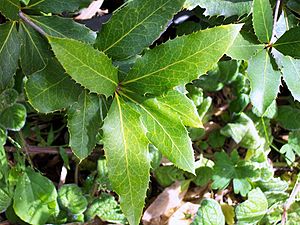Eidothea hardeniana facts for kids
Quick facts for kids Eidothea hardeniana |
|
|---|---|
 |
|
| Nightcap oak leaves at Royal Botanic Gardens, Sydney | |
| Conservation status | |
| Scientific classification | |
| Genus: |
Eidothea
|
| Species: |
hardeniana
|
The Nightcap Oak (scientific name: Eidothea hardeniana) is a special type of tree. It can grow very tall, up to 40 meters (about 130 feet)! This tree belongs to the plant family called Proteaceae.
A botanist named Robert Kooyman first officially recognized this tree as a new species in 2002. It's named hardeniana to honor another botanist, Gwen Harden. Sadly, the Nightcap Oak is now listed as critically endangered in Australia. This means it's at a very high risk of disappearing forever.
Contents
Where the Nightcap Oak Lives
These amazing trees are only found in one small area in the world. They grow naturally in a single creek valley within the Nightcap Range. This area is located in northern New South Wales, Australia.
The Nightcap Oak prefers to grow in warm rainforests. It likes volcanic soils that are not very rich and are a bit acidic. This area also gets a lot of rain. Scientists know of only about 100 wild Nightcap Oak trees left. However, some plants are being grown in places like the Royal Botanic Gardens in Sydney to help protect the species.
Sadly, many of these trees' homes were badly damaged by big bushfires in 2019–2020.
What the Nightcap Oak Looks Like
Nightcap Oak trees have pale bark that is often covered in lichen. This is common for many trees in warm rainforests.
Young Nightcap Oaks and new shoots growing from the base of older trees have spiky leaves. These leaves have sharp teeth along their edges. But as the tree gets older, its leaves become smooth and don't have any teeth.
Flowers and Fruits
The flowers of the Nightcap Oak are a creamy color. They grow in bunches and have a smell like aniseed.
The fruits are large and round. They have a yellow-green skin and a very hard nut inside. The shell of this nut has special ridges, which is unique to this type of tree in its family.
Inside the hard nut is a white seed. This seed might contain natural chemicals that can be poisonous, similar to some types of Macadamia nuts. Even though they might be poisonous, small animals like rodents still chew through the hard nut to eat the seeds. This makes it harder for new Nightcap Oak trees to grow naturally.
Images for kids
See also
 In Spanish: Eidothea hardeniana para niños
In Spanish: Eidothea hardeniana para niños






